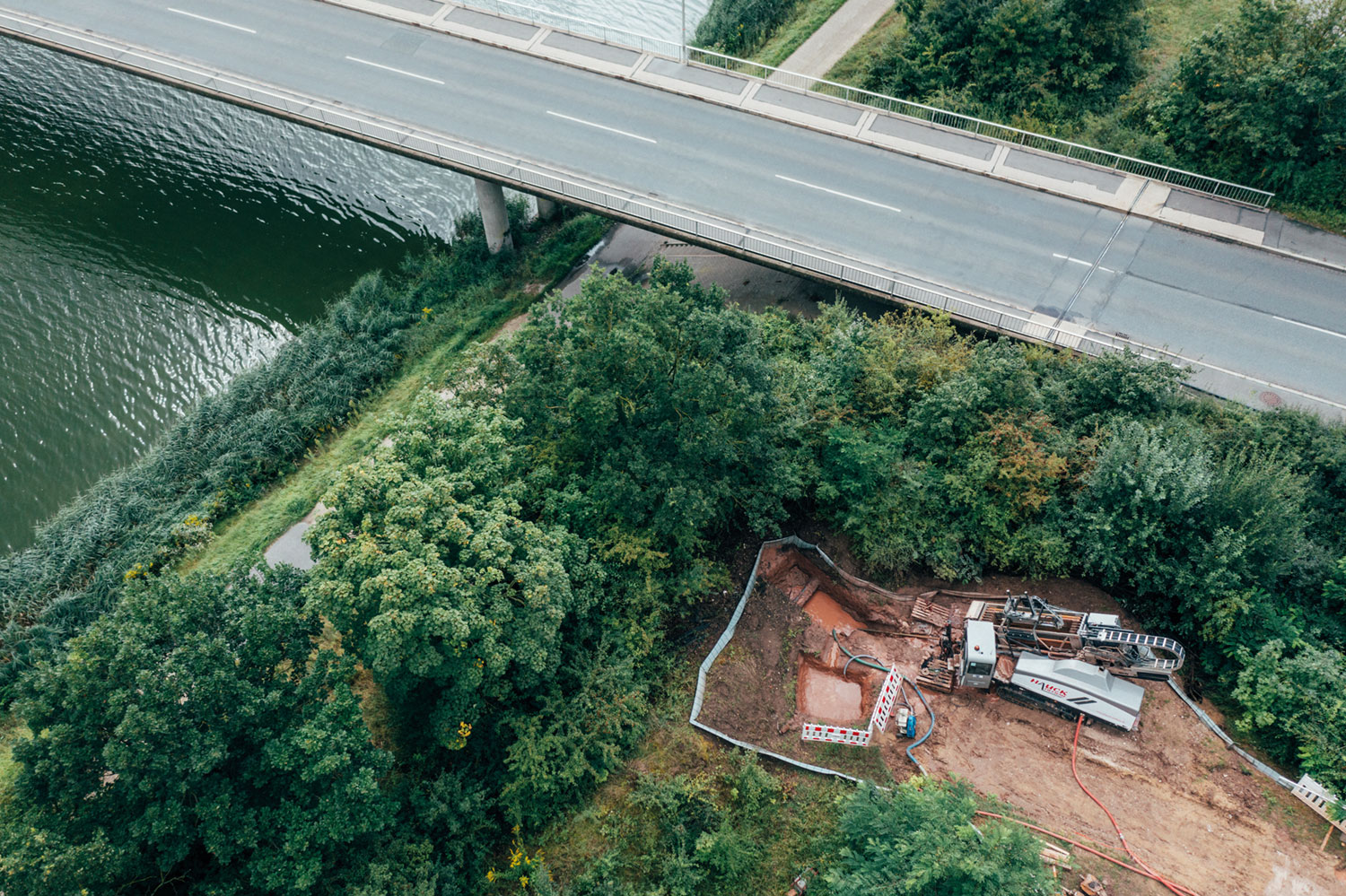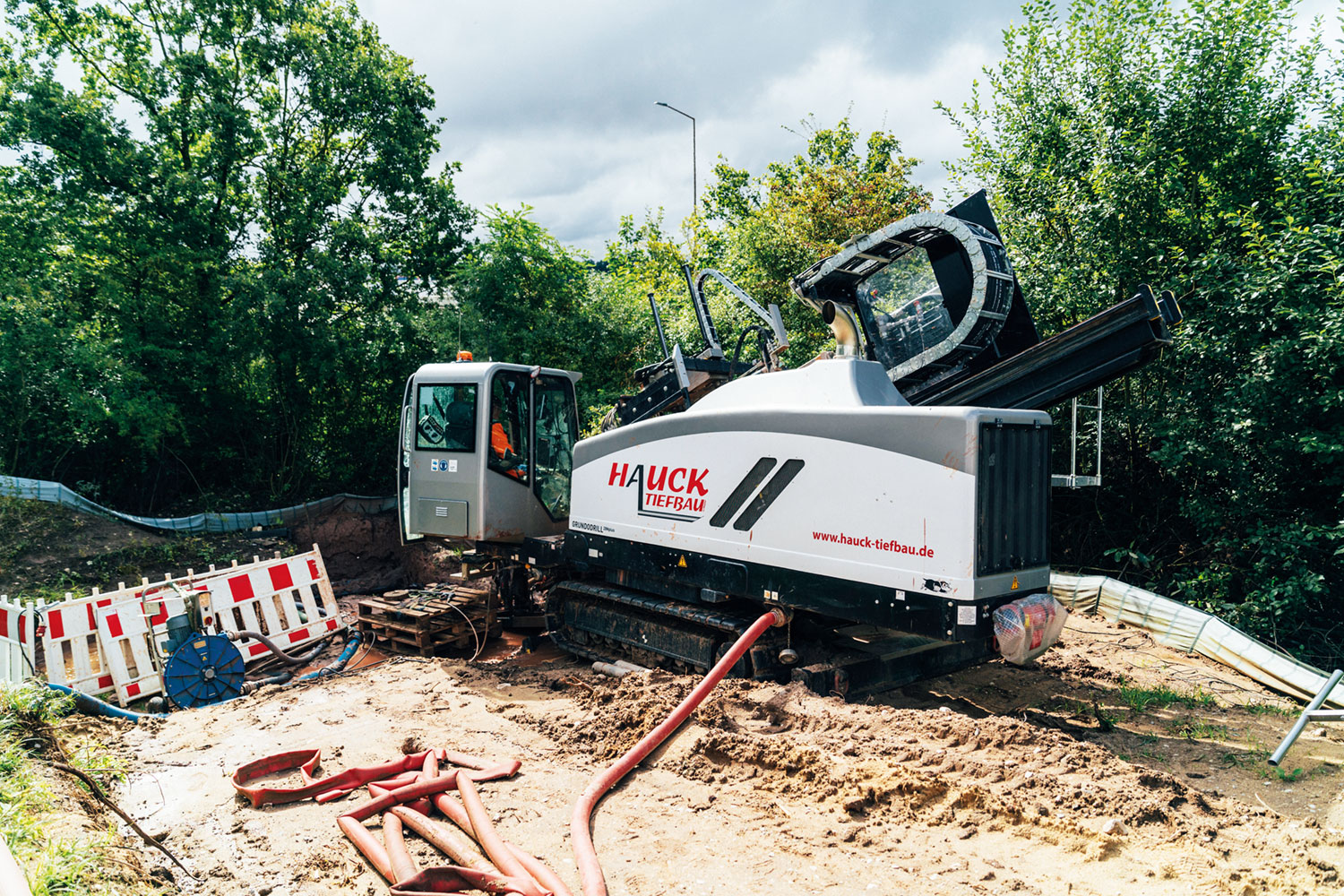In Focus Project: Crossing beneath the Main-Danube-Canal
Crossing beneath the Main-Danube-Canal
When old things get worn out, one question always arises: rebuild or forge new paths? This was also the case with the Fürth harbour bridge on the Main-Danube-Canal. When it was 50 years old, a decision had to be made to either renovate or demolish it. But, in the meantime, what should happen to the service lines for electricity and telecommunications, with the bridge acting as a necessary support for these lines. A clear case for trenchless HDD technology!
The city of Fürth, with a population of just under 130,000 in tranquil Middle Franconia, is part of the Nuremburg metropolitan region together with Erlangen, making it one of the most important economic hubs in Bavaria and especially in the Franconia region. But there is also plenty of idyllic scenery to be found here: Northwest of the old town, the Regnitz meanders past historic buildings, and in the west the Main-Danube-Canal flows in front of the green slopes of the Fürth city forest. Here you will also find the small, but beautiful harbour with its harbour bridge built almost 50 years ago. Precisely this idyllic scene became the setting for an HDD project worth seeing towards the end of 2021, because the ravages of time were irreversibly gnawing away at the bridge in question. Although it was not yet in danger of collapsing, it was still dilapidated enough to demand a decision on demolition or renovation. And this decision was not an easy one to make. For the bridge, which passes the Main-Danube-Canal, not only serves as a traffic link between the two districts of Atzenhof and Unterfarnbach, but also as a support structure for a variety of service lines of the city, from electricity to telecommunications. In addition, the canal is one of the most important waterways in the region. This is exactly where the trenchless HDD technology came into play.


One culvert for multi-supply
The Fürth council was not immediately unanimous about the bridge issue. However, one thing was clear: regardless of whether the bridge was demolished or renovated, the 128,000 citizens of Fürth were to be guaranteed an uninterrupted supply of electricity, internet and telecommunications during the construction work. This task was entrusted to infra fürth GmbH, a municipal company under private law that is responsible for supply and network services in Fürth. infra fürth GmbH immediately realised that there was only one option: crossing under the Main-Danube Canal via a culvert and laying all the supply lines concerned underground.
No small undertaking – apart from the actual building project, all kinds of small and large bureaucratic variables had to be considered in advance, ranging from water law requirements to environmental and nature protection to property conditions. The nature of the building ground also proved to be a challenge. Abrasive sandstone, as well as very tough and equally compact layers of clay, would not only require heavy artillery, but also the highest degree of professional know-how.
The Fürth council was not immediately unanimous about the bridge issue. However, one thing was clear: regardless of whether the bridge was demolished or renovated, the 128,000 citizens of Fürth were to be guaranteed an uninterrupted supply of electricity, internet and telecommunications during the construction work. This task was entrusted to infra fürth GmbH, a municipal company under private law that is responsible for supply and network services in Fürth. infra fürth GmbH immediately realised that there was only one option: crossing under the Main-Danube Canal via a culvert and laying all the supply lines concerned underground.
No small undertaking – apart from the actual building project, all kinds of small and large bureaucratic variables had to be considered in advance, ranging from water law requirements to environmental and nature protection to property conditions. The nature of the building ground also proved to be a challenge. Abrasive sandstone, as well as very tough and equally compact layers of clay, would not only require heavy artillery, but also the highest degree of professional know-how.
Outstanding expertise meets top-class equipment
For the actual pipe installation, infra fürth GmbH decided to appoint Hauck Tiefbau GmbH, a local family-owned company situated between Bamberg and Coburg, providing around 50 years of experience and extensive know-how. Hauck is also known to be a trenchless installation specialist, who combines state-of-the-art technology with the excellent equipment from the company’s own machinery and vehicle fleet.
In this case, however, a particularly powerful and reliable rig was needed: The horizontal directional drilling rig was to drill a cable-guided pilot borehole with a diameter of 170 mm over a length of 200 m and at a depth of 26 m. Due to the narrow site conditions, this was also to be carried out at a particularly steep angle of incidence in the starting pit. Hauck therefore decided to use the GRUNDODRILL 28Nplus horizontal directional drilling rig from TRACTO. After all precaution measures had been taken, it was finally time to get started.
Undercrossing with the GRUNDODRILL 28Nplus
The pilot bore from one riverbank to the other proved to be a real challenge. The GRUNDODRILL 28Nplus had been converted for cable-guided drilling with a mud motor and PDC-chisel, so that a whole bundle of different cable protection pipes could be pulled in. Due to the narrow site conditions, a rather steep penetration angle (55 %) had to be chosen in order to reach the necessary, specified minimum depth under the canal in time. Team and technology took the hurdle with flying colours. After the GRUNDODRILL had reached a depth of 26 m, the drill head worked its way forward metre by metre. Now the challenging subsoil made itself felt.
For the actual pipe installation, infra fürth GmbH decided to appoint Hauck Tiefbau GmbH, a local family-owned company situated between Bamberg and Coburg, providing around 50 years of experience and extensive know-how. Hauck is also known to be a trenchless installation specialist, who combines state-of-the-art technology with the excellent equipment from the company’s own machinery and vehicle fleet.
In this case, however, a particularly powerful and reliable rig was needed: The horizontal directional drilling rig was to drill a cable-guided pilot borehole with a diameter of 170 mm over a length of 200 m and at a depth of 26 m. Due to the narrow site conditions, this was also to be carried out at a particularly steep angle of incidence in the starting pit. Hauck therefore decided to use the GRUNDODRILL 28Nplus horizontal directional drilling rig from TRACTO. After all precaution measures had been taken, it was finally time to get started.
Undercrossing with the GRUNDODRILL 28Nplus
The pilot bore from one riverbank to the other proved to be a real challenge. The GRUNDODRILL 28Nplus had been converted for cable-guided drilling with a mud motor and PDC-chisel, so that a whole bundle of different cable protection pipes could be pulled in. Due to the narrow site conditions, a rather steep penetration angle (55 %) had to be chosen in order to reach the necessary, specified minimum depth under the canal in time. Team and technology took the hurdle with flying colours. After the GRUNDODRILL had reached a depth of 26 m, the drill head worked its way forward metre by metre. Now the challenging subsoil made itself felt.
What actually is a culvert?
A culvert is a tunnel–like structure that is constructed to allow water to flow under a road, railroad or similar obstruction to provide cross drainage or to take electrical or other cables from one side to the other. The system is enclosed by soil or ground.The alternating layers of abrasive sandstone and compact clay were difficult to control in terms of tools and mud. With an average flushing requirement of 300 l/min, progress was slow but steady. And at some point, the opposite riverbank of the Main-Danube-Canal was reached.
This was followed by a total of six expanding processes – the bore head was replaced by a backreamer – up to a final bore hole diameter of 700 mm. After a cleaning-run the protection pipe was filled with water and pulled in; the various cable and service lines were then pulled in and connected to the exposed, existing bore paths on both sides of the Main-Danube-Canal.
The entire construction project – jobsite set up, pilot bore, expanding processes, pulling in the PE-coating pipe and PE-protection pipes, insulation work and civil engineering for the re-connection – took just under two months.
Thanks to the excellent planning by infra fürth GmbH, the professional execution by Hauck’s drilling team and thanks to the power and precision of the GRUNDODRILL 28Nplus, the supply of electricity, fast internet and telecommunications for the inhabitants of Fürth was secured for the future with just one construction project. Breaking new ground is sometimes simply the best option.
This was followed by a total of six expanding processes – the bore head was replaced by a backreamer – up to a final bore hole diameter of 700 mm. After a cleaning-run the protection pipe was filled with water and pulled in; the various cable and service lines were then pulled in and connected to the exposed, existing bore paths on both sides of the Main-Danube-Canal.
The entire construction project – jobsite set up, pilot bore, expanding processes, pulling in the PE-coating pipe and PE-protection pipes, insulation work and civil engineering for the re-connection – took just under two months.
Thanks to the excellent planning by infra fürth GmbH, the professional execution by Hauck’s drilling team and thanks to the power and precision of the GRUNDODRILL 28Nplus, the supply of electricity, fast internet and telecommunications for the inhabitants of Fürth was secured for the future with just one construction project. Breaking new ground is sometimes simply the best option.